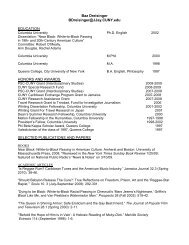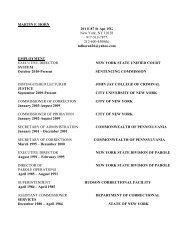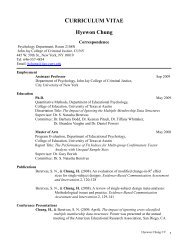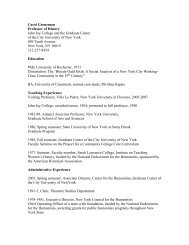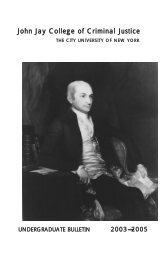Bulletin - John Jay College Of Criminal Justice - CUNY
Bulletin - John Jay College Of Criminal Justice - CUNY
Bulletin - John Jay College Of Criminal Justice - CUNY
You also want an ePaper? Increase the reach of your titles
YUMPU automatically turns print PDFs into web optimized ePapers that Google loves.
Courses <strong>Of</strong>fered<br />
acting and how these reflect the unique social and political<br />
experience of being Latina/o in the United States. The course<br />
combines discussion of the specific texts and acting styles with an<br />
examination of both the creative and literary components. Course<br />
requirements include reading of selected plays in English,<br />
performance of scenes in class, and students will perform their own<br />
works to be showcased at the end of the semester.<br />
Prerequisites: ENG 101 and sophomore standing or above<br />
DRA 222 History of the Drama II<br />
3 hours, 3 credits<br />
A study of the drama and theatre from about 1800 to the present – in<br />
large part the modern stage – with emphasis on the plays and the<br />
methods of staging them.<br />
Prerequisite: ENG 101<br />
DRA 225 <strong>Criminal</strong> <strong>Justice</strong> in the Theatre<br />
3 hours, 3 credits<br />
Investigates the portrayal of violence, conflict, crime, criminals, and<br />
justice on stage and screen and how such representations shape<br />
society's perception of criminal justice issues; also explores uses of<br />
theatrical techniques in conflict intervention, criminal justice<br />
rehabilitation, and law enforcement training. Students will read<br />
plays, attend theatre productions, and may engage in playwriting and<br />
role play as part of their coursework.<br />
Prerequisites: ENG 101 and sophomore standing or above<br />
DRA 230 African-American Theatre<br />
(Same course as AAD 230)<br />
3 hours, 3 credits<br />
A study of the development of the African-American theatre<br />
considering selected works of such playwrights as Langston Hughes,<br />
Lorraine Hansberry, James Baldwin, Imamu Amiri Baraka (LeRoi<br />
Jones), Ed Billings, Charles Gordone, Douglas Turner Ward,<br />
Adrienne Kennedy, Ron Milner, Ben Caldwell, Philip Hayes Dean,<br />
Richard Wesley and Joseph A. Walker, as well as such production<br />
companies as the Spirit House Players and Movers, the Negro<br />
Ensemble Company and the Afro-American Studio Theatre. Plays<br />
focusing on such areas as ethnic identity and lifestyles and<br />
nationalism will be examined.<br />
Prerequisites: ENG 101 and sophomore standing or above<br />
DRA 233 Sociodrama I<br />
3 hours, 3 credits<br />
The course introduces students to the fundamentals of sociodrama.<br />
Sociodrama is a theater-based methodology widely used today in<br />
group problem solving and consensus building. Students explore the<br />
theoretical bases of sociodrama through improvisation, role play and<br />
theater games as they create scenarios around social issues relevant to<br />
the group. Sociodrama techniques, such as freeze frame, role<br />
reversal, mirror and sculpting are taught as a means of exploring<br />
multiple perspectives to solving problems and assessing options.<br />
Prerequisites: ENG 101 and sophomore standing or above<br />
DRA 243 Black Female Sexuality in Film<br />
3 hours, 3 credits<br />
This course examines how film both reflects and shapes the<br />
perception of society about the sexuality of black women. It explores<br />
three black film movements — the pre-Civil Rights era; the 1970s<br />
Blaxploitation era; and the black film culture that has emerged since<br />
the 1980s — from an historical, sociological, and psychological<br />
perspective, illustrating each movement with screenings and<br />
discussion. Films are examined from their cultural archetypal<br />
“feminine” coding, their “messages” and influence, and how<br />
audiences responded to them. The course will also examine films<br />
from the economic and social context in which they were made and<br />
the conditions under which they were produced. Students will<br />
expand their media literacy skills by learning to develop a critical eye<br />
as consumers of media images.<br />
Prerequisites: ENG 101, SPE 113, and sophomore standing<br />
73



